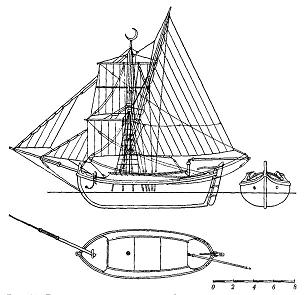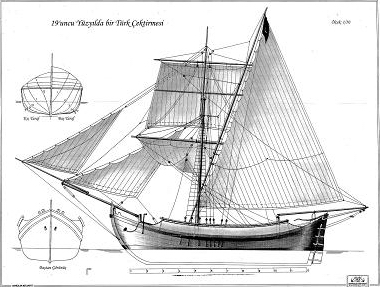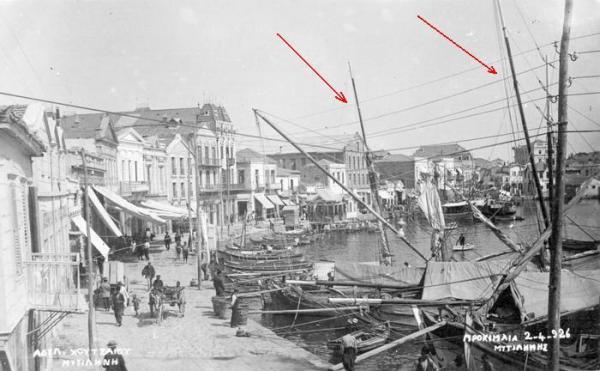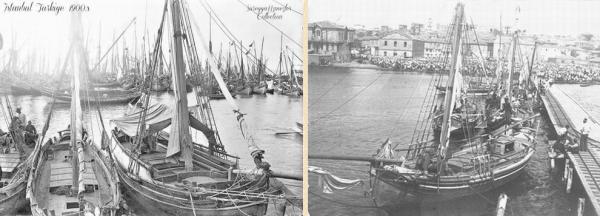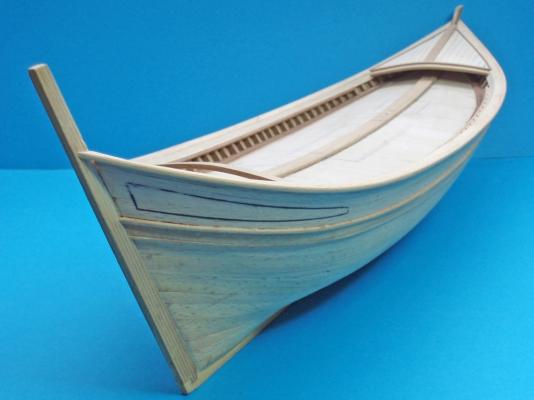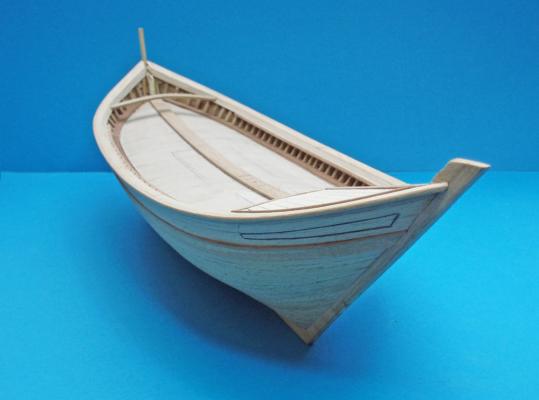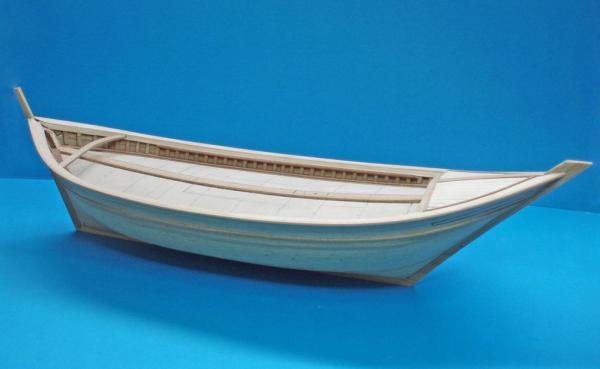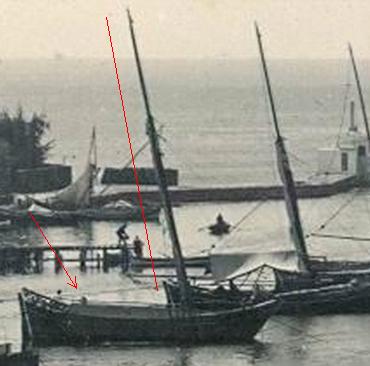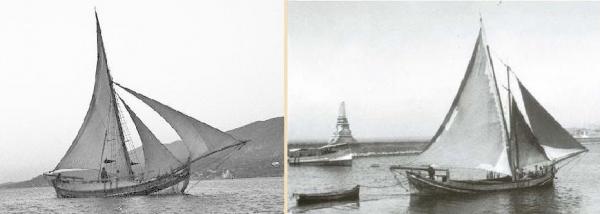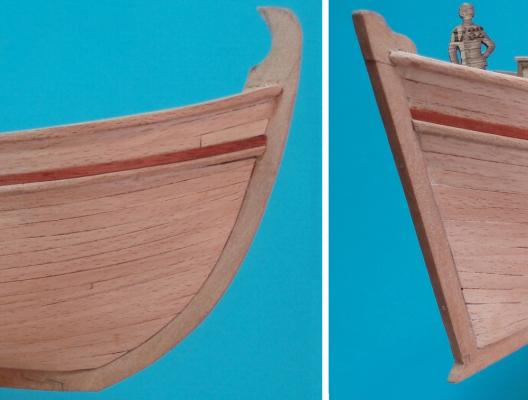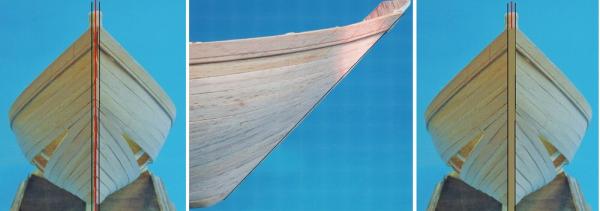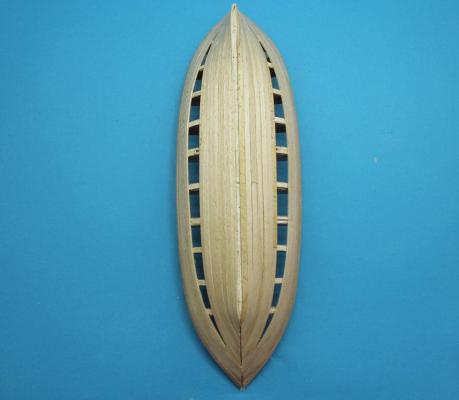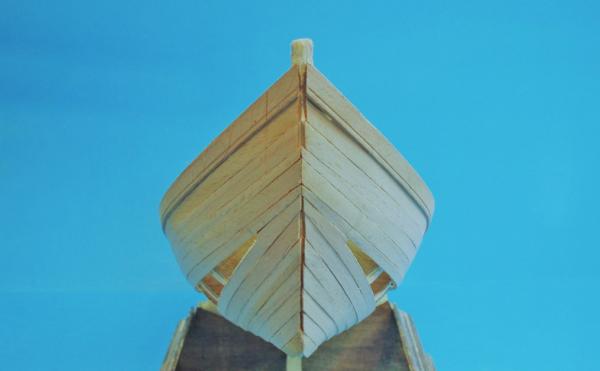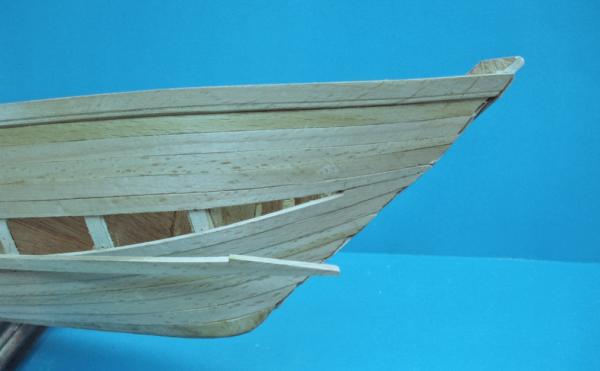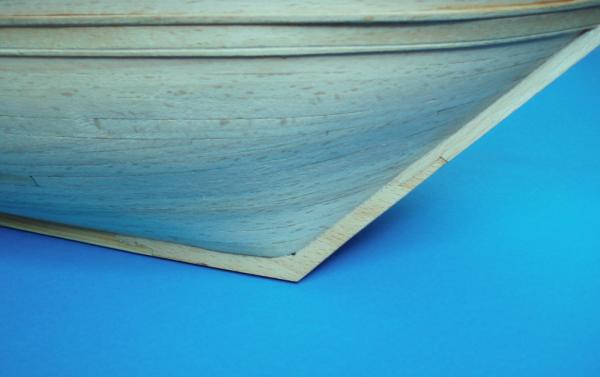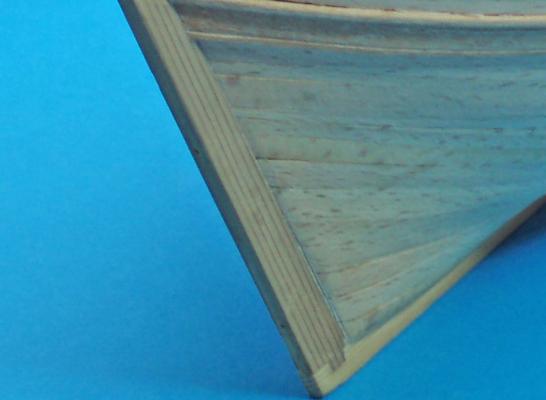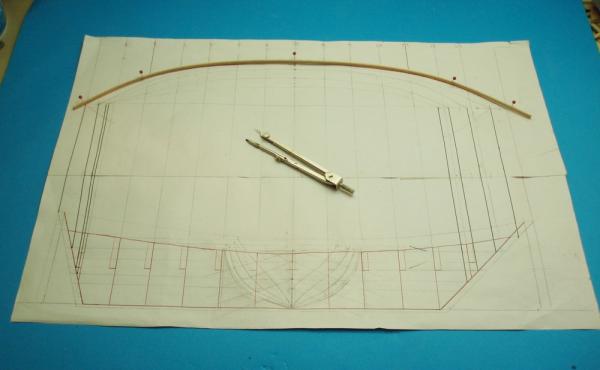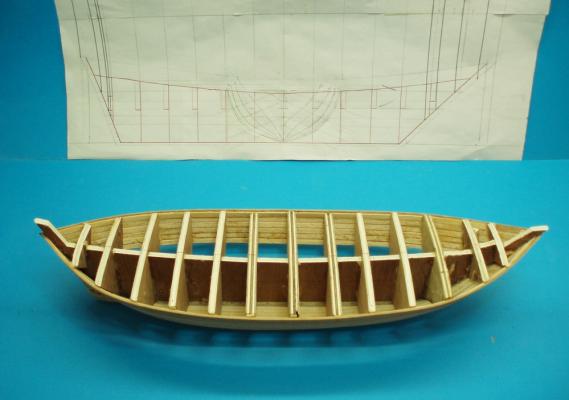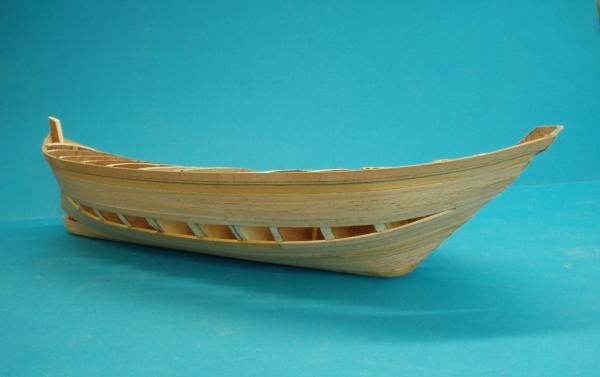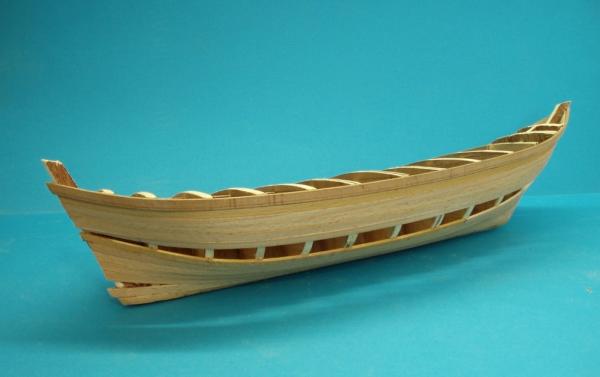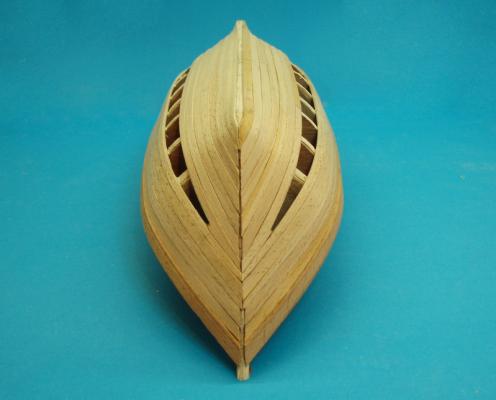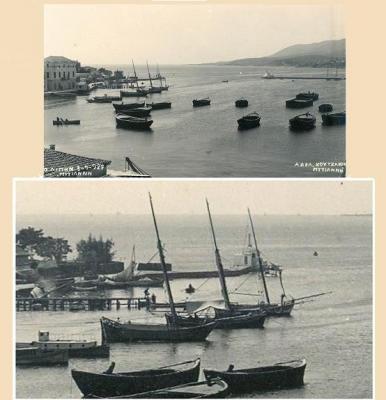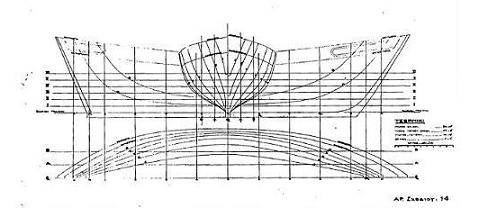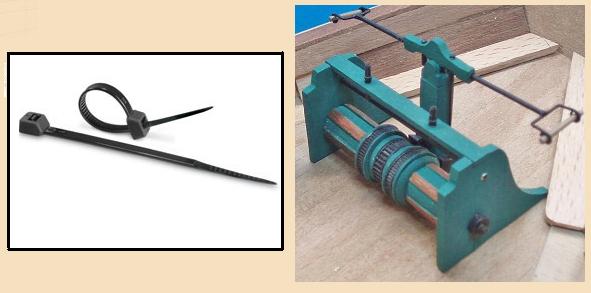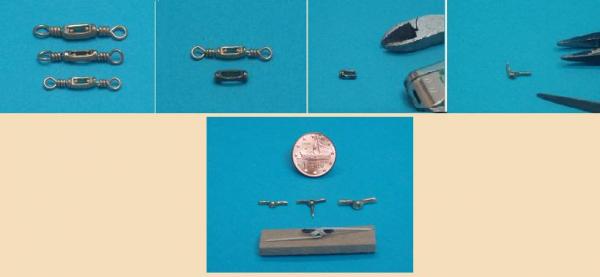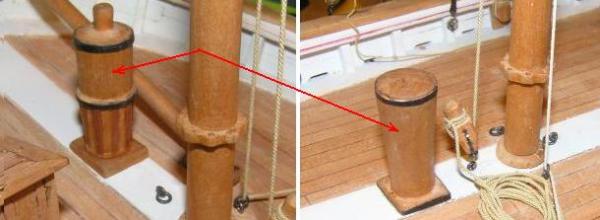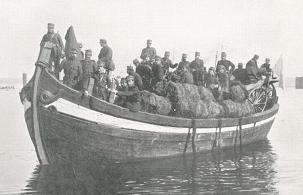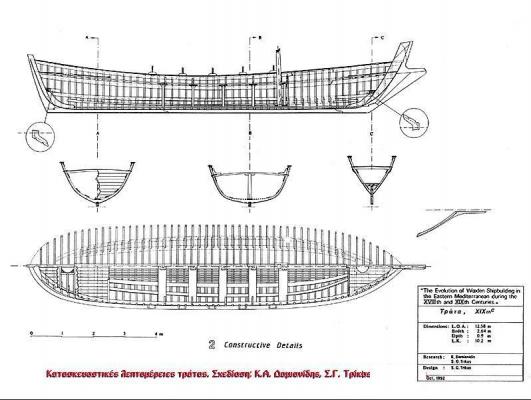-
Posts
651 -
Joined
-
Last visited
Content Type
Profiles
Forums
Gallery
Events
Everything posted by Thanasis
-
So at that time as you can see, penna rigging was consisted mainly by a big triangular sail attached either on a leaning backwards mast, or on a leaning backwards antenna, which in its turn was hanging from a typical mast. The version with the antenna was the older (first) one since there are sources claiming that it was brought in Mediterranean Sea by the Arabs and was first adopted by the Turks. Thus the title of another similar drawing as “Osmanli cektirmesi ” (Ottoman work-boat) referring rather to the type of the boat “çektirme tekne”. ... Back to early 1900’s…Although until the end of the century the “on the mast” version was used by the Greeks, in some photos of NE Aegean ports, those two versions appear side by side. However we can't specify the nationality of those seamen, since at that turbulent time, Islands and boats had changed ownership but also because of the trade between the two coasts, that was kept. ................ I decided to follow the “on the mast” version on my model and so my search turned to that direction. New photos determined the formation of the deck… ................ Thanks
-
Margin plates-false frames and gunwales were set. (I know, I know... but there’s a lack of photos.) ........ ........ At this point and before the formation of the deck, I had to find more details about the penna rigging. My search was continuous in collections and forums, looking for old b/w photos of the area in which that rigging has been developed (ports-historical events of NE Aegean up to western coasts of Black Sea). What I found, in a combination with a few notable points in the photo of the real boat, convinced me that she was rigged as penna. The leaning backwards mast with a sail folded on it and a small shadow of a stem, I considered them as good clues. .................. So, at that time early 1900's according to some information of books and the photos I have found, there seem to be two versions of penna rigging. I think you can see the differences. Thanks To be continued...
-
Thanks for the comment Vaddoc. I don't know what happened to your try but I really never had such a problem, even with a curved stem. You might be using thinner planks than I do. In any case allow me to show you what I do. Planking the hull, I bring the edges of the planks as close they can be at the prow and stern. Preparing the surface to receive the stem, I draw two pencil lines next to the either side of the axis of the prow and at the size as the thickness of the stem. That space between the lines I flatten it, following the proper shape (straight or curved) and taking much care not to go out of those lines. Small repairs are made by white glue and sawdust. Thanks
-
I redrew the plans of the hull at the size of the model I wanted to built, using the extreme method of pencil and paper... I drew the lines of the false keel and the positions of the frames. I cut the false keel and the frames from plywood, while I cut strips of beechwood for the planking. I had chosen the “planking on bulkheads” method and I started building the hull with only one layer of planking. The hull was going to be built up to the level of deck, placing later the final keel, stem and stern-post. Thanks
-
Thank you all. Vadoc you are right . I have also the book you're mentioning and the author (we are known) is cites more at Gr. shipbuilding, classifying the penna sail-rigging (bermuda rigging) as a lateen one (?). I've been always attracted by penna rig and through my amateur research, I think I have come in good results. But one thing at a time... Thx
-
Hi mates. Starting a new model by the end of last summer, I had the drawings of a hull and short of a photo. The drawings were giving me the lines of a hull while the photo, taken in 1927, was showing rather the shape of the real boat. It was a Tserniki vessel being anchored among others, at the port of Mytilene Island (N.E. Aegean Sea) and I thought these would be enough for a good start. Some for the history… Tserniki was a double ended vessel with a straight stem post, leaning forward. Its name might comes from the Turkish vessel “Tsikirne” or from a vessel used on the Danube which was called “Cernik” or “Cirnik”. However it appears to have been used extensively by Greeks and in many other versions. (Different angles of the stem post or even with a stern counter) Tserniki vessels were mainly built by shipwrights of the Eastern Aegean islands and coastal towns of Asia Minor and were used as small transport vessels or fishing boats. Although I had no any rigging plan and the photo was showing nothing more than a single mast, I took the challenge, seeking also the joy of a further research… ............. ................. ... Thanks
-
Thank you all. Greg. You can find those ties in many sizes, while what I usually use (width of 2,5mm &3,5mm -03⁄32in-09⁄64in) I think matches with a scale of 1:25-1:30. Thx
- 396 replies
-
- Idea
- Bright Idea
-
(and 1 more)
Tagged with:
-
- 396 replies
-
- Idea
- Bright Idea
-
(and 1 more)
Tagged with:
-
- 396 replies
-
- Idea
- Bright Idea
-
(and 1 more)
Tagged with:
-
Hi Matija. Congratulation, your model looks great.! I would like to ask you about those "cut stems" close to the masts...Are they a kind of vertical capstans (at least the one in the front looks like) or something else. Many thanks and allow me to place a photo of a "τραμπάκουλο" from the other side of the Adriatic sea. Thx
-
Hi all. Please see also http://modelshipworld.com/index.php/topic/1133-baggywrinkles/?hl=baggywinkles and https://translate.google.com/translate?sl=fr&tl=en&js=y&prev=_t&hl=en&ie=UTF-8&u=http%3A%2F%2Fmrb.modelisme-medias.com%2Farticles%2F45-trucs-a-astuces%2F121-astuces.html&edit-text= Thanks
-
Many thanks for your reply as well for the photos of the procedure Ron. I have already made my experiments and I have also come to similar to your conclusions. However I would like to add that this method of "false seizing", contains also a rate of 15-20 percent of "fault seizing". Thanks
-
Hi all. The issue of false / zip seizing has been set before here… (http://modelshipworld.com/index.php/topic/1255-question-on-false-seizing-zip-seizing/) So Homer, I would like to know weather you have come to an effective way, where the thread doesn't stick on, from whatever kind of material you use as a rod, to make loops around. Many thanks
-
Hi Jerry. Congratulation for your build, it's at least impressive... For the historical accuracy allow me some notes.. The "Sun of Macedonia" actually is the "Vergina Sun" http://en.wikipedia.org/wiki/Vergina_Sun As about the "Macedonian sites" for the time being, there is only Macedonia as a territory at north Greece and a State named by the UN organization as (FYROM). http://en.wikipedia.org/wiki/Macedonia_naming_dispute Thank you
- 97 replies
-
- macedonian
- frigate
-
(and 2 more)
Tagged with:
-
Sorry Zoran. I was attracted by your photos and I didn't noticed your description at that post... Thank you
- 150 replies
-
- TRAJTA
- fishing and cargo boat
-
(and 2 more)
Tagged with:
-
Sorry if you haven't finished but I would like to ask whether this rod on the beak is a potential jib boom, or something else.... Thx
- 150 replies
-
- TRAJTA
- fishing and cargo boat
-
(and 2 more)
Tagged with:
-
- 150 replies
-
- TRAJTA
- fishing and cargo boat
-
(and 2 more)
Tagged with:
-
Thank you Zoran. I have made also my homework... http://arhiv.slobodnadalmacija.hr/20030826/mozaik05.asp Fishes can stay fresh until they reach the shore, by keeping them wet under a tent or by covering them with wet textiles. I tend to believe that since the boat could be heavy loaded and because of the Adriatic sea conditions, it was safer to sail as a closed hull boat, rather than as an open one. But I leave it to the fishermen... Thx
- 150 replies
-
- TRAJTA
- fishing and cargo boat
-
(and 2 more)
Tagged with:
-
Hi Zoran. Sorry if I didn't make myself clear... I'm not judging the model, I'm sure you're going by the draft... I'm just trying to figure out, why the real boat ( sailing also by the use of oars) had to be covered in most of it's part with a deck. Thx
- 150 replies
-
- TRAJTA
- fishing and cargo boat
-
(and 2 more)
Tagged with:
-
Are those four (4) hatches covering small storerooms, or just openings for the fishermen to be standing up inside, while they pull up the nets from the sea... Thx
- 150 replies
-
- TRAJTA
- fishing and cargo boat
-
(and 2 more)
Tagged with:
-
At http://it.wikipedia.org/wiki/Leudo I found this... Leudo "Il leudo o loido (in lingua italiana leuto o liuto, in lingua ligure lœidu o leûdo pron. /'løɪdu/[1]) è il vocabolo dato, in Liguria, ad una famiglia di barche a vela latina che sono state utilizzate per le attività di cabotaggio (trasporto di merci) fino agli ultimi decenni nel Novecento, in tutta l'area mediterranea." Translated "The leudo or loido (in Italian lute or lute , in the Ligurian language lœidu or Leudo pron. / 'løɪdu / [1] ) is the term given, in Liguria , to a family of boats with lateen sails that were used for the cabotage (for freight transport) until the last few decades in the twentieth century , in the whole Mediterranean area." Well after this mix-up (?) I think the title of the build log should being referred to Trajta only as a fishing boat. Thx
- 150 replies
-
- TRAJTA
- fishing and cargo boat
-
(and 2 more)
Tagged with:
-
Zoran, I really don't know... As the log goes on, I think the only connection between those two vessels apart of the name is just something... drom the beak. I think Gr Trata comes more narrow and long. It was an open hull boat, with small decks at the bow and stern in some versions...Its purpose was the fishing itself and not just the transportation of the catch. Sailing mainly by the use of oars, there were benches for the paddlers. See the below drawing from the book "The evolution of shipbuilding in the Eastern Mediterranean during the 18th-19th centuries." and you can see more photos of Trata vessels at http://www.naftotopos.gr/index.php?option=com_phocagallery&view=category&id=246:trata&Itemid=622〈=el Allow me also two queries... -As in the real boat I guess, you placed a bulwark on the left side of the stern to keep the nets on deck...But if she was made just to transport the catch, what the necessity for nets to be on her deck. -From what kind of vessels she was collecting the catch to be transferred ashore. Thx
- 150 replies
-
- TRAJTA
- fishing and cargo boat
-
(and 2 more)
Tagged with:
About us
Modelshipworld - Advancing Ship Modeling through Research
SSL Secured
Your security is important for us so this Website is SSL-Secured
NRG Mailing Address
Nautical Research Guild
237 South Lincoln Street
Westmont IL, 60559-1917
Model Ship World ® and the MSW logo are Registered Trademarks, and belong to the Nautical Research Guild (United States Patent and Trademark Office: No. 6,929,264 & No. 6,929,274, registered Dec. 20, 2022)
Helpful Links
About the NRG
If you enjoy building ship models that are historically accurate as well as beautiful, then The Nautical Research Guild (NRG) is just right for you.
The Guild is a non-profit educational organization whose mission is to “Advance Ship Modeling Through Research”. We provide support to our members in their efforts to raise the quality of their model ships.
The Nautical Research Guild has published our world-renowned quarterly magazine, The Nautical Research Journal, since 1955. The pages of the Journal are full of articles by accomplished ship modelers who show you how they create those exquisite details on their models, and by maritime historians who show you the correct details to build. The Journal is available in both print and digital editions. Go to the NRG web site (www.thenrg.org) to download a complimentary digital copy of the Journal. The NRG also publishes plan sets, books and compilations of back issues of the Journal and the former Ships in Scale and Model Ship Builder magazines.



